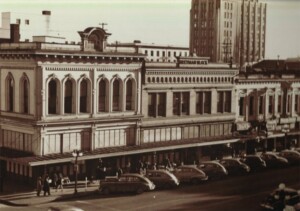174 Commercial Street NE
(Historic Downtown Salem)
Classification: Historic Contributing
Historic Name: Breyman Brothers Block
Current Name: Bike Peddler/McEwan Photo
Year of Construction: 1904/1940s/1960s
Legal Description: 073W27AB8200; Salem from Lots 7, Block 33 (See also 188 Commercial, same owner, Lot 8300)
Owner(s): Evan Boise, et al
Also included in this structure is address 180 Commercial St., NE
Salem, Or 97301

Photographic print showing the SE corner of Commercial and Court Streets, featuring the Breyamn Bros. Building (1874), Bryman Block, Chop Suey Restaurant, and the Livelsey Building in the distance., WHC Collections 2017.028.0004
Description: This two-story building, constructed in 1904, was remodeled in the late 1940s to its current stucco finished Modern style appearance. The second-floor fenestration of the west elevation has four bays with each bay containing two large one-over-one, double-hung wood sash windows. The building to the north was remodeled at the same time to have the same exterior appearance.
The ground-floor facade has an umbrella-type awnings arching out over the sidewalk. The ground floor storefronts incorporate recessed entrances with tile floors and tile bulkheads (c.1940s), and newer display windows and transoms that have aluminum sash (c.1960s).
This building retains sufficient historic fabric and design to describe the 1940s. The changes to the storefront are typical of the area and do not significantly diminish the integrity of the structure. This building contributes to the historic character of the downtown district.
History and Significance: This building replaced three buildings from the 1870s and was constructed c.1904 as retail spaces and offices and to be part of the “Breyman Block”. The so-called “Breyman Block” of brick featured four bays of paired windows on the second floor with a corbelled cornice and stepped parapet with an upper edge that was slightly shorter than the adjoining Breyman Brothers block to the north. Retail shops occupied the ground floor with offices on the second floor. Both Breyman buildings remained relatively unchanged until the late 1940s when the Breyman/Boise family had the exterior of both buildings completely updated and modernized. All decorative ornamentation was stripped away and replaced with a smooth sleek wall (except for three indented narrow horizontal bands above the second-floor windows), evocative of the then-popular International style of architecture. This sudden transformation, which catapulted the buildings into the mid-twentieth century, unified their appearance. The exterior appearance of both buildings, which has changed little since mid-century, reflects this waning era of downtown commercial business and of efforts to revive it in the mid-1900s.
Werner and Eugene Breyman contributed to the commercial development of several communities in the Willamette Valley, including Amity, Lafayette, Portland, and Salem. Natives of Bockenem, Hanover, Germany, Werner and Eugene Breyman immigrated to the United States (Wisconsin) in 1846 and 1853, respectively. Werner traveled overland to Oregon Country from Milwaukee, Wisconsin, in 1850; Eugene departed Wisconsin, in 1855 by way of the Isthmus of Panama. In 1856 the two brothers formed a partnership and undertook numerous business ventures over the next half century. They operated a general merchandise store in Lafayette, Oregon, and at a crossroads that became the nucleus of Amity. They brought their mercantile acumen to Salem in 1863-64, opening a store first in the Moore block at the northwest corner of Commercial and State streets and, in 1874, in the Breyman Brothers, or “White Corner,” building. Their business was said to be the largest retail and wholesale general merchandise store in Oregon outside Portland. The brothers retired from merchandising in 1880 and turned to real estate development and the loan business. Over the next two decades, Werner and Eugene Breyman owned and developed Midland and Rosedale additions to Salem, and had financial interests in the Sunnyside, Eastland, and Boise additions in Portland. Additionally, they held stock in several regional banks. Both men were long-time members of the Masonic fraternity. The family homes of both Breyman brothers were centers of social life in Salem in the 1800s.
Descendants of the two Breyman families continued their involvement in Salem’s business community for over a century and a half. Werner and Isabella Watt Breyman, who were married in the early 1850s, raised three (of a total of seven) children who lived to adulthood: Anna Prael (of Portland), Elva Brown, and Ada Eldredge (resident of Manila). Eugene and Margaret E. Skaife Breyman raised three daughters: Lena M. Snedecor (of Birmingham, Alabama), Minnie L. Boise, and Jessie A. McNary. Each of the Breyman children appeared to have acquired 1/6 of an interest in the Breyman brothers’ property at the corner of Commercial and Court streets. Lucille and Reuben Breyman Boise became intimately associated with the Breyman brothers’ property by the late 1940s. Reuben Breyman Boise was the son of Reuben P. Boise who had been a newspaperman at the Salem Oregon Statesman and at the Tacoma, Washington, Daily News, as well as being a Salem realtor and financier. Reuben Breyman Boise was also the grandson of Reuben P. Boise, an 1850 Oregon pioneer, circuit judge, and Chief Justice of the Oregon Supreme Court. In the year 2000, this property remains under Boise family ownership.
This article originally appeared on the original Salem Online History site and has not been updated since 2006.







Leave A Comment